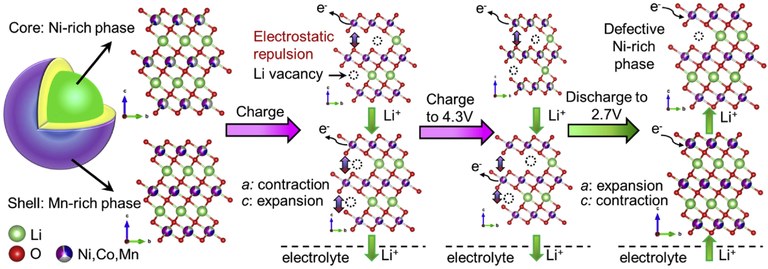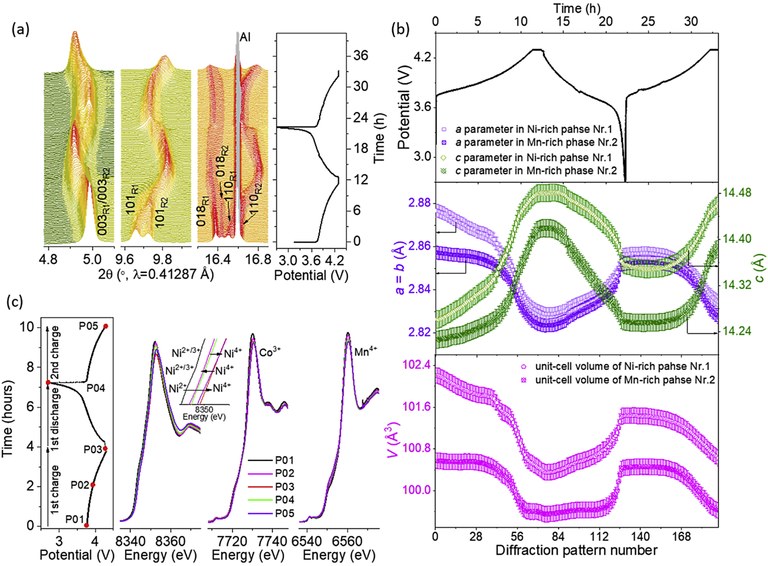
Figure. Schematic illustration of a subsequent (de)lithiation mechanism in the core-shell NCM cathode materials during the first cycle, showing an obvious change in the unit-cell volume of the Ni-rich phase within the interior region of a secondary particle with respect to the Mn-rich phase. TM: Ni – whitish; Mn – magenta; Co – blue.
Cerdanyola del Vallès, September 21, 2020. LiNixCoyMn1-x-yO2 (NCM) intercalation compounds with core-shell architecture have been found to be promising cathode candidates for next-generation lithium-ion battery applications. The NCM cathodes functional properties are dependent on the transition metal relative ratios, making a challenge to control the real structure of core-shell NCM cathode materials and to understand the synergistic effect of core and shell during the electrochemical cycling.
An international research group featuring researchers from the State Key Laboratory of Electronic Thin Films and Integrated Devices (University of Electronic Science and Technology of China); the Institute for Applied Materials (Karlsruhe Institute of Technology, Germany ); the Technische Universität München (Germany) and the ALBA Synchrotron has developed a universal and facile synthetic strategy to synthesize a NCM material for the lithium-ion batteries, which are composed of an inner Ni-rich core and a Mn-rich shell. The material combines high capacity of the Ni-rich phase and high stability of the Mn-rich phase thus providing improved electrochemical properties compared to any of these phases taken separately.
This study provides new insights into the synergistic effect of the two layered phases in the core-shell morphology on the electrochemical performance of NCM cathode materials. These findings also offer a new perspective for rational design of layered Ni-based cathode materials with high energy and long cycling life with particular two phase electrochemical characteristics.
The core-shell material was synthesized by sequential co-precipitation of the transition metal hydroxides followed by reaction of the obtained precursor with lithium carbonate. The crystal structure of the pristine material was determined by simultaneous refinement of the synchrotron X-ray powder diffraction data- taken at the MSPD beamline in the ALBA Synchrotron - and neutron powder diffraction data - SPODI beamline at Neutron Research Source Heinz Maier (Leibnitz, Germany). The mechanism of the charge/discharge processes was analyzed using in situ synchrotron powder diffraction – also at the MSPD beamline in ALBA - and in situ X-ray absorption spectroscopy – at the CLAESS beamline in ALBA.

Figure. Data obtained at MSPD and CLAESS beamlines in the ALBA Synchrotron. (De)Lithiation mechanism of core-shell NCM cathode materials during cycling. (a) SRD reflection evolution of the core-shell NCM electrode during the first charge-discharge and the second charge process. (b) variation of lattice parameter as a function of de-lithiation and lithiation process, lattice parameters of each SRD pattern reveal a good structural stability for the Mn-rich phase Nr.2. (c) in situ XANES spectra at Ni, Co, and Mn K-edges of the core-shell NCM cathode during cycling.
Reference: Weibo Hua, Björn Schwarz, Raheleh Azmi, Marcus Müller, Mariyam Susana Dewi Darma, Michael Knapp, Anatoliy Senyshyn, Michael Heere, Alkesandr Missyul, Laura Simonelli, Joachim R. Binder SylvioIndris, Helmut Ehrenberg. Lithium-ion (de)intercalation mechanism in core-shell layered Li(Ni,Co,Mn)O2 cathode materials. Nano Energy (2020). DOI: https://doi.org/10.1016/j.nanoen.2020.105231




